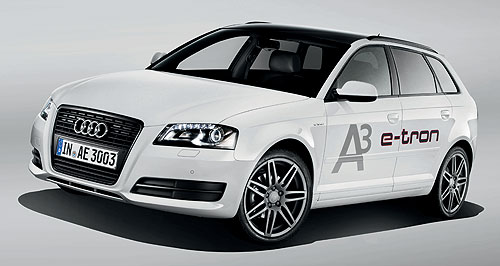Make / Model Search
Future models - Audi - A3 - e-tronFirst drive: Next A3 Sportback set to plug inFuture tech: The Audi A3 e-tron we drove was based on the soon-to-be-superseded current model. Audi’s electric hatch will hit the road, just not in the guise you see here22 Nov 2011 By BYRON MATHIOUDAKIS in JAPAN AUDI’S e-tron “future mobility” concepts will range from the Urban 1+1-seater city electric vehicle (EV) first seen at this year’s Frankfurt motor show to an electrified next-generation R8 supercar due in 2013. But the A3 is the model most likely to spawn the most affordable, mainstream e-tron from the four-ringed marque over the next five years, in the new third-generation that is due to appear in standard petrol and diesel forms next year. Audi gave Australian journalists a taste of the future with a drive of a battery-equipped current second-generation A3 Sportback e-tron just outside Tokyo last week, on an 11km strip of closed mountain road. A regular production A3 Sportback 1.4TSI was on hand for comparison. Powered by a permanent-magnet synchronous motor and a scattering of lithium-ion batteries totalling 380 volts and storing 26.5kWh of energy in the centre and rear of the car, the A3 Sportback e-tron is a proper battery electric vehicle (BEV) with zero emissions (from the car itself) – unlike the rotary-engined range extender engine charging up the batteries in the A1 e-tron. Adding about 300kg to the regular current-gen A3 Sportback, the e-tron is no slouch, channelling up to 100kW of power and 270Nm of torque through to the front wheels via a single-speed transmission.  In EVs, the 0-60km/h sprint time is what counts, since most are designed to operate in inner-urban conditions, and here the Audi does not disappoint, at 5.3 seconds. In EVs, the 0-60km/h sprint time is what counts, since most are designed to operate in inner-urban conditions, and here the Audi does not disappoint, at 5.3 seconds.Even approaching its top speed of a (limited) 145km/h, the A3 e-tron feels a strong performer, even if the 11.2 second 0-100km/h result suggests otherwise. When the driver applies the brakes with force, the electric motor acts as a generator to recover braking energy. The car has paddles on either side of the steering wheel to control the amount of regenerative braking at three levels, with the top one feeling like you’re resting your foot lightly on the brakes. Audi says the A3 Sportback e-tron takes nine hours to recharge on a 230-volt power supply, or three hours on a 400-volt three-phase power supply. Range is roughly 140km. With no corners other than a couple of kinks to contend with, rating the steering and body control was difficult, but at 1592kg, the Audi is no lightweight. Interestingly, it is the A2 Concept that debuted at this year’s Frankfurt show that best illustrates the potential of the A3 Sportback e-tron, even though it will be a smaller vehicle by the time the production version arrives in about 2015. Shaving more than two seconds off its 0-100km/h dash, the A2 Concept delivers the same power and torque outputs but has 60km more range and takes less than half the time to recharge, due to the fact it weighs a staggering 450kg less. This is largely thanks to an aluminium space-frame construction with a superstructure consisting largely of aluminium components and add-on carbon fibre-reinforced polymer parts. We understand that Audi is working hard on making the next-gen A3 Sportback e-tron lighter than the existing prototype. Whatever the outcome, it is clear the company is well advanced with its burgeoning to the point of bewildering e-tron vehicle strategy, be it a Micro-Hybrid, Mild-Hybrid, Plug-in Hybrid, Range Extender, BEV, Fuel Cell EV ...  Read moreAll future models Alfa Romeo Alfa Romeo Abarth Abarth Alpine Alpine Alpina Alpina Audi Audi Aston Martin Aston Martin BMW BMW Bentley Bentley Chery Chery Brabham Brabham Chrysler Chrysler Chevrolet Chevrolet Cupra Cupra Citroen Citroen DS DS Dodge Dodge Fiat Fiat Ferrari Ferrari Foton Foton Ford Ford Great Wall Great Wall FPV FPV Haval Haval GWM GWM Honda Honda Holden Holden Hummer Hummer HSV HSV Infiniti Infiniti Hyundai Hyundai Jaguar Jaguar Isuzu Isuzu Kia Kia Jeep Jeep Land Rover Land Rover Lamborghini Lamborghini Lexus Lexus LDV LDV Mahindra Mahindra Lotus Lotus Mazda Mazda Maserati Maserati Mercedes-AMG Mercedes-AMG McLaren McLaren MG MG Mercedes-Benz Mercedes-Benz Mitsubishi Mitsubishi Mini Mini Opel Opel Nissan Nissan Peugeot Peugeot Pagani Pagani Proton Proton Porsche Porsche Renault Renault Ram Ram Rover Rover Rolls-Royce Rolls-Royce Skoda Skoda Saab Saab SsangYong SsangYong Smart Smart Suzuki Suzuki Subaru Subaru Toyota Toyota Tesla Tesla Volvo VolvoA3 pricing
Motor industry news |
Click to shareAudi modelsAll future models Alfa Romeo Alfa Romeo Abarth Abarth Alpine Alpine Alpina Alpina Audi Audi Aston Martin Aston Martin BMW BMW Bentley Bentley Chery Chery Brabham Brabham Chrysler Chrysler Chevrolet Chevrolet Cupra Cupra Citroen Citroen DS DS Dodge Dodge Fiat Fiat Ferrari Ferrari Foton Foton Ford Ford Great Wall Great Wall FPV FPV Haval Haval GWM GWM Honda Honda Holden Holden Hummer Hummer HSV HSV Infiniti Infiniti Hyundai Hyundai Jaguar Jaguar Isuzu Isuzu Kia Kia Jeep Jeep Land Rover Land Rover Lamborghini Lamborghini Lexus Lexus LDV LDV Mahindra Mahindra Lotus Lotus Mazda Mazda Maserati Maserati Mercedes-AMG Mercedes-AMG McLaren McLaren MG MG Mercedes-Benz Mercedes-Benz Mitsubishi Mitsubishi Mini Mini Opel Opel Nissan Nissan Peugeot Peugeot Pagani Pagani Proton Proton Porsche Porsche Renault Renault Ram Ram Rover Rover Rolls-Royce Rolls-Royce Skoda Skoda Saab Saab SsangYong SsangYong Smart Smart Suzuki Suzuki Subaru Subaru Toyota Toyota Tesla Tesla Volvo VolvoA3 pricing
Motor industry news |











Facebook Twitter Instagram